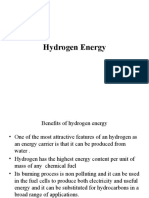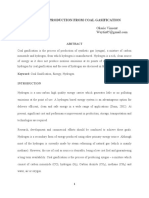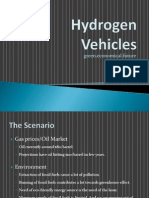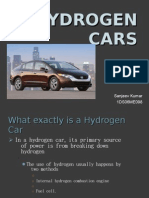0 ratings0% found this document useful (0 votes)
64 viewsSeminar On Hydrogen Fuel Cell Vehicle Seminar On Hydrogen Fuel Cell Vehicle
Seminar On Hydrogen Fuel Cell Vehicle Seminar On Hydrogen Fuel Cell Vehicle
Uploaded by
koche222This document summarizes a seminar on hydrogen fuel cell vehicles. It defines hydrogen as the simplest element, discusses how it can be produced from various renewable sources, and its chemical properties. It then provides a brief history of hydrogen fuel cells and vehicles. The document outlines different types of fuel cell vehicles and hydrogen storage methods. It discusses the potential infrastructure needed to support hydrogen vehicles and some applications like automobiles, buses, motorcycles. Finally, it discusses advantages like being clean burning but also challenges around production and storage of hydrogen.
Copyright:
© All Rights Reserved
Available Formats
Download as PPTX, PDF, TXT or read online from Scribd
Seminar On Hydrogen Fuel Cell Vehicle Seminar On Hydrogen Fuel Cell Vehicle
Seminar On Hydrogen Fuel Cell Vehicle Seminar On Hydrogen Fuel Cell Vehicle
Uploaded by
koche2220 ratings0% found this document useful (0 votes)
64 views26 pagesThis document summarizes a seminar on hydrogen fuel cell vehicles. It defines hydrogen as the simplest element, discusses how it can be produced from various renewable sources, and its chemical properties. It then provides a brief history of hydrogen fuel cells and vehicles. The document outlines different types of fuel cell vehicles and hydrogen storage methods. It discusses the potential infrastructure needed to support hydrogen vehicles and some applications like automobiles, buses, motorcycles. Finally, it discusses advantages like being clean burning but also challenges around production and storage of hydrogen.
Original Title
hfcvppt-140511044920-phpapp01.pptx
Copyright
© © All Rights Reserved
Available Formats
PPTX, PDF, TXT or read online from Scribd
Share this document
Did you find this document useful?
Is this content inappropriate?
This document summarizes a seminar on hydrogen fuel cell vehicles. It defines hydrogen as the simplest element, discusses how it can be produced from various renewable sources, and its chemical properties. It then provides a brief history of hydrogen fuel cells and vehicles. The document outlines different types of fuel cell vehicles and hydrogen storage methods. It discusses the potential infrastructure needed to support hydrogen vehicles and some applications like automobiles, buses, motorcycles. Finally, it discusses advantages like being clean burning but also challenges around production and storage of hydrogen.
Copyright:
© All Rights Reserved
Available Formats
Download as PPTX, PDF, TXT or read online from Scribd
Download as pptx, pdf, or txt
0 ratings0% found this document useful (0 votes)
64 views26 pagesSeminar On Hydrogen Fuel Cell Vehicle Seminar On Hydrogen Fuel Cell Vehicle
Seminar On Hydrogen Fuel Cell Vehicle Seminar On Hydrogen Fuel Cell Vehicle
Uploaded by
koche222This document summarizes a seminar on hydrogen fuel cell vehicles. It defines hydrogen as the simplest element, discusses how it can be produced from various renewable sources, and its chemical properties. It then provides a brief history of hydrogen fuel cells and vehicles. The document outlines different types of fuel cell vehicles and hydrogen storage methods. It discusses the potential infrastructure needed to support hydrogen vehicles and some applications like automobiles, buses, motorcycles. Finally, it discusses advantages like being clean burning but also challenges around production and storage of hydrogen.
Copyright:
© All Rights Reserved
Available Formats
Download as PPTX, PDF, TXT or read online from Scribd
Download as pptx, pdf, or txt
You are on page 1of 26
SEMINAR ON
HYDROGEN FUEL CELL VEHICLE
PRESENTED BY,
RAGHU SAI.G
3NA10ME021
UNDER GUIDEANCE,
PROF. ASHOK MALIPATIL
DEFINATION OF HYDROGEN
Simplest element in the universe
one proton and one electron
Occurs naturally as a gas
Can be used to create energy
through combustion or use in fuel
cells
Most hydrogen is bonded to oxygen
in the form of water (H2O)
Can be produced through the use of
nuclear, solar, wind, and other
renewable sources
Diversity of sources
make hydrogen available
alternative fuel
Steam methane
reforming (CH4 )
CHEMICAL PROPERTIES OF HYDROGEN
Makes up 75% of the mass of all visible
matter
Nontoxic and nonpoisonous
Rarely found alone (H2) usually bonded to
oxygen in water (H2O)
Highly buoyant lighter than air, rises and
diffuses when leaked
Hydrogen Colour
Hydrogen smell
Hydrogen flame identification
BASIC HISTORY OF
HYDROGEN
1820s Rev. W. Cecil developed
hydrogen-fueled engine
1876 Nicolaus Otto invented four-
cylinder engine;
1885 Gottleib Daimler invented
modern ICE
1920s first testing of the hydrogen ICE
Rudolf Erren used hydrogen ICEs in
submarines and land vehicles
General Motors coined the phrase
hydrogen economy during the fuel
crisis of the 1970s
As fuel prices returned to normal,
interest in hydrogen vehicles
diminished
Rising fuel prices, environmental
concerns, and energy security
sparked interest again in the twenty-
first century
ALTERNATE FUEL CELL VEHICLE
HYBRIDS
ETHANOL/E85
Here now, but still require gas Pushed
by GM
More expensive, just as dirty?
HYDROGEN FUEL CELL
Fuel cells are similar to
batteries, but designed
for continuous
replenishment of energy
via external fuel
Many different types of
fuel cells, most common
will likely be the PEM FC
Hydrogen and oxygen
in, water vapor and
liquid water out
Typical output is about .
8 volts
WORKING OF HYDROGEN FUEL CELL
TYPES OF FUEL CELL
VEHICLE
Hydrogen Internal Combustion Engine
Dual-Fuel Hydrogen Vehicles
Hydrogen Fuel Cell Vehicles
Concept Vehicles
HYDROGEN SOURCES
Cooling at
atmospheric
Pressure= -253 c
Std heating value
H2 gas =12.1 MJ/cu
m
Std heating value
of liquid H2 = 120
MJ/Kg
HYDROGEN FUEL CELL
VEHICLE INFRASTRUCTURE
Hydrogen Production
Almost all of the hydrogen produced in the U.S.
today is by steam reforming of natural gas
Produce hydrogen directly from new nuclear
power reactors?
R&D into several new methods:
Biological Water Splitting
Photoelectrochemical Water Splitting
Reforming of Biomass and Wastes
Solar Thermal Water Splitting
Renewable Electrolysis
THE HYDROGEN HIGHWAY
-Worlds first hydrogen refueling
station opened in Iceland in 2003
California & Florida have both
approved funding
BC Hydrogen Highway will
link Vancouver & Whistler
by start of 2010
Winter Olympic Games
HYDROGEN STORAGE
Compressed gas storage
Liquid storage(cryogenic storage)
Line pack system
Under ground storage
Storage as metal hydride
APPLICATION
Automobiles
Although there are currently no fuel cell cars
available for commercial sale, over 20 FCEVs
prototypes and demonstration cars have been
released since 2009. Automobiles such as the
GM HydroGen4,Honda FCX Clarity,
Toyota FCHV-advandMercedes-Benz F-Cellare
all pre-commercial examples of fuel cell
electric vehicles. Fuel cell electric vehicles
have driven more than 3 million miles, with
more than 27,000 refuelings.
Buses
There are also demonstration models of
buses,and in total there are over 100
fuel cell busesdeployed around the world today.
Most of these buses are produced by UTC Power,
Toyota, Ballard, Hydrogenics, and Proton Motor.
UTC buses have already accumulated over
970,000km (600,000mi) of driving.
Fuel cell buses have a 30-141% higher fuel
economy than diesel buses and natural gas
buses.
Motorcycles and bicycles
In 2005 the British firmIntelligent Energyproduced
the first ever working hydrogen runmotorcyclecalled
theENV(Emission Neutral Vehicle).
The motorcycle holds enough fuel to run for four
hours, and to travel 160km (100mi) in an urban area,
at a top speed of 80km/h (50mph).
In 2004Hondadeveloped afuel-cell motorcyclewhich
utilized the Honda FC Stack.There are other examples
of bikesand bicycleswith a hydrogen fuel cell engine.
The Suzuki Burgman received "whole vehicle type"
approval in the EU.
Airplanes
Boeingresearchers and industry partners throughout
Europe conducted experimental flight tests in
February 2008 of a mannedairplanepowered only by
a fuel cell and lightweightbatteries.
The Fuel Cell Demonstrator Airplane, as it was called,
used a Proton Exchange Membrane (PEM) fuel cell/
lithium-ion battery hybrid system to power an
electric motor, which was coupled to a conventional
propeller.
In 2003, the world's first propeller driven airplane to
be powered entirely by a fuel cell was flown.
ADVANTAGES
Created from water, can be recycled to produce more
hydrogen
Cleanest fuel available when combusted produces
carbon monoxide, carbon dioxide, or hydrocarbon
emissions
Leaks/spills will quickly evaporate and do not pose any
threats to the environment
Domestic production will allow for energy
independence
DISADVANTAGE
Conceptually, replacing the current oil-based
infrastructure withhydrogenwould cost billions,
maybe trillions, of dollars.
Although abundant in the universe,hydrogenis
fairly rare in our atmosphere, meaning that it has to
be extracted (for example through electrolysis, as
explained above) and currently, the process is cost
prohibitive and inefficient.
It is a very flammable gas (think of the Hindenburg),
which further adds to the on-board storage problems.
its production at energy plants creates excessive
carbon dioxide.
Hydrogen Technology Development
In India
Production of hydrogen by photo electrolysis of
water using solar energy
Production of hydrogen by blue green algae & by
certain bacterial species
Storage of hydrogen through metal hydride / non
metal hydride
Problems relating to utilization of hydrogen as a
fuel,that is developed for certain engines and fuel
etc.
Liquid hydrogen production, storage and
utilization.
CONCLUSION
Hydrogen Fuel cell vehicles are currently being
researched for their feasibility of widespread usage
in automobiles and other forms of transportation.
Hydrogen fuel does not occur naturally on Earth
and thus is not an energy source, but is an energy
carrier. Currently it is most frequently made from
methane or other fossil fuels .
However, it can be produced from a wide range of
sources (such as wind, solar, or nuclear) that are
intermittent, too diffuse or too cumbersome to
directly propel vehicles.
REFERENCE
National Renewable Energy Laboratory
http://www.nrel.gov/hydrogen/proj_produc
tion_delivery.html
DoE Alternative Fuels Data Center
http://www.eere.energy.gov/afdc/laws/ep
act_2005.html
Hydrogen Fuel Cell Realm
http://www.geocities.com/aardduck/fc_bas
ic.html
Non conventional energy source G D rai
2006 edition
FuelCellWorks.com
THANK
YOU
You might also like
- Data Communication QuestionsDocument6 pagesData Communication QuestionsEngr. Mansoor Habib100% (3)
- Malicious Intent - Nikolas Cruz's AccompliceDocument643 pagesMalicious Intent - Nikolas Cruz's AccompliceAlan Jules Weberman50% (4)
- The 20-kg Punching Bag Has A Radius ...Document3 pagesThe 20-kg Punching Bag Has A Radius ...JulioNo ratings yet
- A L T A: Symmetric Inguistic Rends NalysisDocument25 pagesA L T A: Symmetric Inguistic Rends Nalysisfestival valNo ratings yet
- Hydrogen Fuel Cell VehicleDocument3 pagesHydrogen Fuel Cell VehicleMohammed Elmohands100% (1)
- Hydrogen: The "Forever Fuel" That We Can Never Run Out ofDocument26 pagesHydrogen: The "Forever Fuel" That We Can Never Run Out ofSunil AroraNo ratings yet
- Module 3Document31 pagesModule 3thripthi shettyNo ratings yet
- Hydrogen EconomyDocument69 pagesHydrogen Economyprittam008No ratings yet
- HYDROGEN (1) MergedDocument30 pagesHYDROGEN (1) MergedAbcNo ratings yet
- Hydrogen CarDocument18 pagesHydrogen CarLeela SaiNo ratings yet
- Eldakiki How We Can Produce HydrogenDocument10 pagesEldakiki How We Can Produce HydrogenMohamed Gaber El-NaggarNo ratings yet
- The Manufacturing and Storage of Hydrogen (23!03!2019)Document19 pagesThe Manufacturing and Storage of Hydrogen (23!03!2019)Aditya KumarNo ratings yet
- 03 ΕΚΤΑ 03 ΠΑΡΟΥΣΙΑΣΗDocument76 pages03 ΕΚΤΑ 03 ΠΑΡΟΥΣΙΑΣΗthod3rNo ratings yet
- Harnessing Hydrogen For Power: Hydrogen CarsDocument18 pagesHarnessing Hydrogen For Power: Hydrogen CarsNabeel KhanNo ratings yet
- Wikipedia On Hydrogen VehicalDocument12 pagesWikipedia On Hydrogen VehicalParihar RaviNo ratings yet
- Teknologi Energi Hidrogen 31-03-2020Document81 pagesTeknologi Energi Hidrogen 31-03-2020erniNo ratings yet
- Harnessing Hydrogen For Power: Hydrogen CarsDocument18 pagesHarnessing Hydrogen For Power: Hydrogen CarsDixi ModiNo ratings yet
- FulesDocument17 pagesFulesadilNo ratings yet
- The Hydrogen Economy Presentation Notes (1)Document19 pagesThe Hydrogen Economy Presentation Notes (1)ali6905427No ratings yet
- The-Hydrogen-Economy-Presentation-Notes (1)Document19 pagesThe-Hydrogen-Economy-Presentation-Notes (1)ali6905427No ratings yet
- Unit 8-Hydrogen and Fuel CellsDocument54 pagesUnit 8-Hydrogen and Fuel Cellsbrock_33_992862No ratings yet
- Fuel Cells For SpaceDocument17 pagesFuel Cells For SpaceKshitiz SinhaNo ratings yet
- Microsoft Word - pn186Document4 pagesMicrosoft Word - pn186MekineNo ratings yet
- Alternate Fuel For Maritime UseDocument4 pagesAlternate Fuel For Maritime Useprateek prakashNo ratings yet
- The Global Shift Towards Clean EnergyDocument22 pagesThe Global Shift Towards Clean Energyغازي عليNo ratings yet
- Hydrogen Production From Coal GasificatiDocument10 pagesHydrogen Production From Coal GasificatiProsperNo ratings yet
- Fuel Cars Based On Cell TechnologyDocument27 pagesFuel Cars Based On Cell TechnologyAsad SaeedNo ratings yet
- Hydrogen EconomyDocument19 pagesHydrogen EconomyEdgar Gabriel Sanchez DominguezNo ratings yet
- Dayalbagh Educational Institute: Faculty of EngineeringDocument14 pagesDayalbagh Educational Institute: Faculty of EngineeringShubham100% (2)
- Introduction To HydrogenDocument22 pagesIntroduction To HydrogenSunil AroraNo ratings yet
- SeminarDocument25 pagesSeminarYahiya AhammedNo ratings yet
- Hydrogen Engine ProjectDocument17 pagesHydrogen Engine ProjectScribdTranslationsNo ratings yet
- Water Fuel Engine Copy 2Document26 pagesWater Fuel Engine Copy 2ankitkamanalli230No ratings yet
- Alternative FuelsDocument30 pagesAlternative FuelsSatish HS0% (1)
- Green - Economical.future: Mayank Batra ME - 1508311 NcceDocument19 pagesGreen - Economical.future: Mayank Batra ME - 1508311 NcceVineet BhokarNo ratings yet
- 15701A03B1Document20 pages15701A03B1Suri VijayNo ratings yet
- Hydrogen Basics: Hydrogen As An Alternative FuelDocument9 pagesHydrogen Basics: Hydrogen As An Alternative FuelSiddhesh BhavsarNo ratings yet
- 39 1pbsedaDocument21 pages39 1pbsedaLohith B.YNo ratings yet
- Hydrogen Fuel Cell TechnologyDocument16 pagesHydrogen Fuel Cell Technologysanthosh nagaNo ratings yet
- Hydrogen EconomyDocument22 pagesHydrogen EconomyManohar ReddyNo ratings yet
- Hydrogen Economy: Keith Hohn Associate Professor Department of Chemical Engineering Kansas State University Hohn@ksu - EduDocument33 pagesHydrogen Economy: Keith Hohn Associate Professor Department of Chemical Engineering Kansas State University Hohn@ksu - EdumaliwalnehaNo ratings yet
- Water BikeDocument7 pagesWater BikeBibekananda JujharsinghNo ratings yet
- Hydrogen Economy - Siddharth ModiDocument31 pagesHydrogen Economy - Siddharth Modidi_la_raaNo ratings yet
- Hydrogen Fuel CellDocument6 pagesHydrogen Fuel CellAhmed SamiNo ratings yet
- Hydrogen - Activities in The Oil & Gas Sector: R & D Centre, NTPC, NoidaDocument32 pagesHydrogen - Activities in The Oil & Gas Sector: R & D Centre, NTPC, NoidaJina DevNo ratings yet
- Hydrogen TechnologyDocument47 pagesHydrogen Technologymudassar Mudassar AliNo ratings yet
- Water Fuel Engine With Power GenerationDocument7 pagesWater Fuel Engine With Power GenerationSantosh Anand100% (1)
- Hydrogen Fuel CellDocument4 pagesHydrogen Fuel CellNayli SorfinaNo ratings yet
- Energy Engineering Fundamentals (ME-539) : Department of Mechanical Engineering IIT - (BHU)Document28 pagesEnergy Engineering Fundamentals (ME-539) : Department of Mechanical Engineering IIT - (BHU)shantanubanerjee.mec24No ratings yet
- Final ReportDocument18 pagesFinal Report037 Amit SemwalNo ratings yet
- Fuel Cell and It's Application 2Document25 pagesFuel Cell and It's Application 2Maharghya BiswasNo ratings yet
- Hydrogen For TransportationDocument5 pagesHydrogen For Transportationrussell_hodgesNo ratings yet
- Fuel Cells: Negative Anode Positive CathodeDocument0 pagesFuel Cells: Negative Anode Positive Cathodevarunun131No ratings yet
- Auto ProjectDocument8 pagesAuto ProjectSarath Jr.No ratings yet
- Hydrogen: Fuel For The FutureDocument14 pagesHydrogen: Fuel For The FutureVipul SinghNo ratings yet
- Fuels in General: Notebook: Literature Review Created: 12-02-2018 09:43 Updated: 14-02-2018 10:38 Author: Karthick V UrlDocument5 pagesFuels in General: Notebook: Literature Review Created: 12-02-2018 09:43 Updated: 14-02-2018 10:38 Author: Karthick V UrlSourav KarthickNo ratings yet
- Hydrogen As Future FuelDocument3 pagesHydrogen As Future Fuelekichi_onizuka83% (6)
- HydrogenDocument24 pagesHydrogenmeet003No ratings yet
- SanjeevDocument21 pagesSanjeevAbhijeet VermaNo ratings yet
- HFC Hydrogen Fuel Cell Cars: The Next Generation in Electric CarsFrom EverandHFC Hydrogen Fuel Cell Cars: The Next Generation in Electric CarsNo ratings yet
- Hydrogen Energy: Challenges and Solutions for a Cleaner FutureFrom EverandHydrogen Energy: Challenges and Solutions for a Cleaner FutureNo ratings yet
- 5 SDocument27 pages5 Sr0wanNo ratings yet
- Tunable Multifunctional Topological Insulators in Ternary Heusler CompoundsDocument5 pagesTunable Multifunctional Topological Insulators in Ternary Heusler CompoundsAnna LindströmNo ratings yet
- Development Studies Notes Module 1-8 2022 WwordDocument232 pagesDevelopment Studies Notes Module 1-8 2022 Wwordletangletty07No ratings yet
- GeoTech - 43-2913 - Residential Development - Avenue LDocument27 pagesGeoTech - 43-2913 - Residential Development - Avenue Lhunain shoukatNo ratings yet
- Case Study: New Artist's Residency by Toshiko MoriDocument10 pagesCase Study: New Artist's Residency by Toshiko MoriJay PatelNo ratings yet
- Build Your Own Shipping Container Home - The Beginner's Guide (PDFDrive)Document74 pagesBuild Your Own Shipping Container Home - The Beginner's Guide (PDFDrive)4scribduser100% (1)
- Clasification of AmplifiersDocument20 pagesClasification of Amplifiersvaishnavi1994No ratings yet
- A Study On The Effects of Cashless Transactions On People'S Spending Behaviour in Sirkazhi Town, Mayiladuthurai DistrictDocument14 pagesA Study On The Effects of Cashless Transactions On People'S Spending Behaviour in Sirkazhi Town, Mayiladuthurai DistrictGLOBAL INFO-TECH KUMBAKONAMNo ratings yet
- Alina A. Malofeeva,, And: Anton F. Seleznev Giovanni CarraroDocument9 pagesAlina A. Malofeeva,, And: Anton F. Seleznev Giovanni CarraroMagic DamyataNo ratings yet
- 15 ახალი ტესტი ინგლისურშიDocument85 pages15 ახალი ტესტი ინგლისურშიverikoNo ratings yet
- Certiorari CamachoDocument35 pagesCertiorari CamachoAlexandrina VictoriaNo ratings yet
- Sustainability Plan PDFDocument51 pagesSustainability Plan PDFCarl Williams100% (1)
- Saturn Facts: Saturn Is The Sixth Planet From The Sun and The Second LargestDocument2 pagesSaturn Facts: Saturn Is The Sixth Planet From The Sun and The Second LargestMaurinne Angeline GuloyNo ratings yet
- D Sundararajan LpaperDocument19 pagesD Sundararajan LpapersoumensahilNo ratings yet
- Short InteriorDocument14 pagesShort InteriorAnonymous SprjYZANo ratings yet
- Lesson Plan For SetsDocument9 pagesLesson Plan For SetsNorce LynNo ratings yet
- Homescan: CPS Module 2Document34 pagesHomescan: CPS Module 2mithunrecdgp100% (1)
- Crusty But Trusty WorkbenchDocument4 pagesCrusty But Trusty WorkbenchtsonjjdNo ratings yet
- Da68-04023j-02 Manual Users en Mes CFR Rf9000a F-HubDocument248 pagesDa68-04023j-02 Manual Users en Mes CFR Rf9000a F-HubNeal JarmuskeNo ratings yet
- Windows Rootkits A Game of "Hide and Seek"Document28 pagesWindows Rootkits A Game of "Hide and Seek"alexduqueNo ratings yet
- The Danger of His Silence DisciplineDocument18 pagesThe Danger of His Silence DisciplineAsaba isaacNo ratings yet
- David Cunning - Cavendish-Routledge (2016)Document12 pagesDavid Cunning - Cavendish-Routledge (2016)Claudia AguilarNo ratings yet
- NLC Energy Operations at Denmark WI ProjectDocument13 pagesNLC Energy Operations at Denmark WI ProjectManikandan SWMSNo ratings yet
- ESIC Employee Aadhaar SeedingDocument24 pagesESIC Employee Aadhaar SeedingShowkat Ganie HussainNo ratings yet
- University of Makati Higher School NG UmakDocument51 pagesUniversity of Makati Higher School NG UmakJason CapatiNo ratings yet
- Advance Project Managemeny Hilti 5000Document29 pagesAdvance Project Managemeny Hilti 5000Nadia RiazNo ratings yet

























































































